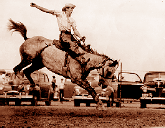Part I
Origins and Growth
 Rodeo
was born during the 1860s and 1870s with informal
contests held among working cowboys. Common at seasonal
roundups, such "cowboy fun" tested typical
skills like bronc riding and steer roping. Between 1890
and 1910, rodeo emerged as public entertainment through
various Wild West Shows and performances at Fourth of
July celebrations and cattlemen's conventions. Rodeo
was born during the 1860s and 1870s with informal
contests held among working cowboys. Common at seasonal
roundups, such "cowboy fun" tested typical
skills like bronc riding and steer roping. Between 1890
and 1910, rodeo emerged as public entertainment through
various Wild West Shows and performances at Fourth of
July celebrations and cattlemen's conventions.
Rodeo came to be recognized as a competitive spectator
sport during the first decades of the twentieth century.
Annual stampedes, roundups and frontier days events
attracted regional audiences and contestants throughout
the West. By the mid-1920s, championship events at Boston
Garden and New York City's Madison Square Garden were
drawing nationwide attention to the new sport.
Promoters and Contractors
 Rodeo moved from cowboy sport to public entertainment
through the efforts of early promoters. In the spirit of
Wild West Show entrepreneurs, these men saw the
opportunity of making rodeo a distinctively American
pageant. Their vision, organizational ability and funding
helped popularize the sport far beyond its western
origins. Today, such individual promoters have been
replaced largely by local rodeo committees.
Rodeo moved from cowboy sport to public entertainment
through the efforts of early promoters. In the spirit of
Wild West Show entrepreneurs, these men saw the
opportunity of making rodeo a distinctively American
pageant. Their vision, organizational ability and funding
helped popularize the sport far beyond its western
origins. Today, such individual promoters have been
replaced largely by local rodeo committees.
An integral part of rodeo since the early twentieth
century, contractors supply the horses, bulls, steers and
calves which are essential to the sport. Rodeo
contractors must be sound and energetic businessmen, as
well as excellent judges of livestock. Today, there are
nearly fifty stock contractors providing spirited animals
for the more than 600 Professional Cowboys Rodeo
Association (PRCA) sanctioned rodeos held in the United
States each year.
Organization
Founded in 1929, the Rodeo Association of America
(RAA) was a body of managers and promoters which brought
structure to rodeo programming. The RAA sanctioned
events, selected judges and established purse awards and
point systems to determine all-around champions. Since
1946 the organization has acted as the International
Rodeo Association (IRA).
Rodeo contestants remained independent and unorganized
until 1936, when a stalwart group formed the Cowboys
Turtle Association (CTA) during a strike at the Boston
Garden World Championship. The CTA sought larger purse
awards, competent judges and application of uniform rules
throughout the rodeo system. In 1945 the CTA became the
Rodeo Cowboys Association (RCA), and was retitled the
Professional Rodeo Cowboys Association (PRCA) in 1975.
Women in Rodeo
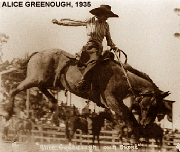 While men traditionally have dominated
the sport, women were prominent performers in rodeo
during the first half of this century. As both rough
stock and trick riders (some even tried bulldogging),
their ability and daring attracted enthusiastic
audiences. Beginning in the 1930s, however, female
contestants increasingly were restricted to race and
trick riding. While men traditionally have dominated
the sport, women were prominent performers in rodeo
during the first half of this century. As both rough
stock and trick riders (some even tried bulldogging),
their ability and daring attracted enthusiastic
audiences. Beginning in the 1930s, however, female
contestants increasingly were restricted to race and
trick riding.
As rodeo became more professional in the 1950s, women
declined in number and prominence within the sport.
Showmanship gradually was overshadowed by concerns for
fast action and increased earnings. Today, female
participation in rodeo, under the auspices of the Women's
Professional Rodeo Association (WPRA), centers on barrel
racing, a timed event with prize moneys in excess of a
half million dollars annually.
Trick Riders and Fancy Ropers
Unknown to many of today's rodeo fans, trick riding
and fancy roping were popular, contested events during
the 1920s and 1930s. Based on Wild West spectaculars,
these competitions required athletes with skills beyond
those of the normal rodeo cowboy. After 1933, however,
such exhibitions became contract entertainment and
gradually lost their popularity and place in the sport.
Trick riding, which demanded calm, steady-gaited
horses and daring, acrobatic contestants, was adapted in
rodeo programming largely from the stunts of Cossack
performers in the Wild West shows. By contrast, trick and
fancy roping originated almost entirely among the Charro
riders of Old Mexico and was introduced into the United
States around 1900 by Vincente Oropeza (1975 Rodeo Hall
inductee).
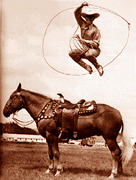 Designed for acrobatics on horseback, the
trick riding saddle incorporates a number of special
features. The extended hom allows a central handhold for
moving into, and recovering from maneuvers like the
"pass under" and the "Russian drag."
Handholds behind the cantle are for crupper tricks such
as the "roll-up" off the rear of the horse. And
the various support straps allow control in dramatic
layover and standing stunts. Designed for acrobatics on horseback, the
trick riding saddle incorporates a number of special
features. The extended hom allows a central handhold for
moving into, and recovering from maneuvers like the
"pass under" and the "Russian drag."
Handholds behind the cantle are for crupper tricks such
as the "roll-up" off the rear of the horse. And
the various support straps allow control in dramatic
layover and standing stunts.
Trick and fancy ropers usually employ two types of
ropes for different types of stunts. Catching ropes are
made of stiff maguey fiber (from a species of Mexican
aleo plant) for control in tossing large loops like the
"ocean wave" and the "figure eight."
Spinning ropes, by contrast, are made of soft braided
cotton for smooth motion in making patterns like the
"Spanish flat," "butterfly loop" and
"zig zag."
Professionalism
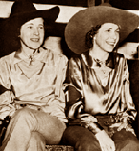 Between 1950 and 1970, continuing growth
and organization brought professionalism to rodeo. The
formation of the National Intercollegiate Rodeo
Association (NIRA) in 1948 laid the groundwork for an
expanding pool of skilled contestants. And the
inauguration of the National Finals Rodeo in 1959
provided the ultimate arena for deciding annual
all-around and individual event champions. Between 1950 and 1970, continuing growth
and organization brought professionalism to rodeo. The
formation of the National Intercollegiate Rodeo
Association (NIRA) in 1948 laid the groundwork for an
expanding pool of skilled contestants. And the
inauguration of the National Finals Rodeo in 1959
provided the ultimate arena for deciding annual
all-around and individual event champions.
During the 1950s and 1960s, better management, greater
attention from the sports media and increases in
scheduled events, purses and attendance brought dramatic
changes to rodeo. With such incentives and improved
transportation, many contestants went "on the
circuit" full-time, evolving from occasional
performers to professional athletes of national stature.
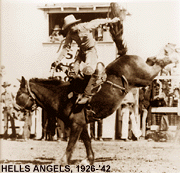 Rodeo continued to organize through the
1940s and 1950s. Association publications like Hoofs
and Homs and The Buckboard helped create a
common identity among the sport's many participants.
During the Second World War, many outstanding rodeo
contestants joined the armed forces. The sport continued,
however, as a patriotic fund raising event in support of
the war effort. Rodeo gear, and the rules for its use,
continued to be refined. In particular, saddle design was
significantly influenced by the needs of roping
contestants. Rodeo continued to organize through the
1940s and 1950s. Association publications like Hoofs
and Homs and The Buckboard helped create a
common identity among the sport's many participants.
During the Second World War, many outstanding rodeo
contestants joined the armed forces. The sport continued,
however, as a patriotic fund raising event in support of
the war effort. Rodeo gear, and the rules for its use,
continued to be refined. In particular, saddle design was
significantly influenced by the needs of roping
contestants.
The 1950s are known as the "Golden Age of
Rodeo" because great champions like Jim Shoulders,
Casey Tibbs, Bill Linderman and Harry Tompkins dominated
the sport. In recent decades, training camps, such as
those run by Jim Shoulders and Larry Mahan, have
contributed to the development and excellence of
professional rodeo athletes.
The increasing professionalism, prominence and
earnings of rodeo have created a "new breed of
cowboys" who are well-traveled and well-educated,
articulate and enterprising. As with other professional
athletes, rodeo contestants have turned to physical
conditioning and modern sports medicine to maintain a
competitive edge over a year-long season.
Big Business
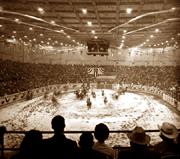 During the 1960s and 1970s, television
created a financial and spectator explosion in rodeo.
Commercial sponsorship now amounts to some eight million
dollars annually, with more than two million in direct
prize money. Prominent corporate sponsors include Justin
Boot Company, Wrangler Western Wear, Adolph Coors
Company, U.S. Tobacco Company and Hesston Farm Equipment
Company. During the 1960s and 1970s, television
created a financial and spectator explosion in rodeo.
Commercial sponsorship now amounts to some eight million
dollars annually, with more than two million in direct
prize money. Prominent corporate sponsors include Justin
Boot Company, Wrangler Western Wear, Adolph Coors
Company, U.S. Tobacco Company and Hesston Farm Equipment
Company.
Overall attendance and the number of sanctioned events
and contestants have markedly increased as well. Today,
more than 650 PRCA events are held each year, attracting
an audience in the millions. Ranking contestants compete
in more than 100 rodeos per year for total prize money in
excess of twelve million dollars plus a variety of
valuable awards.
|
